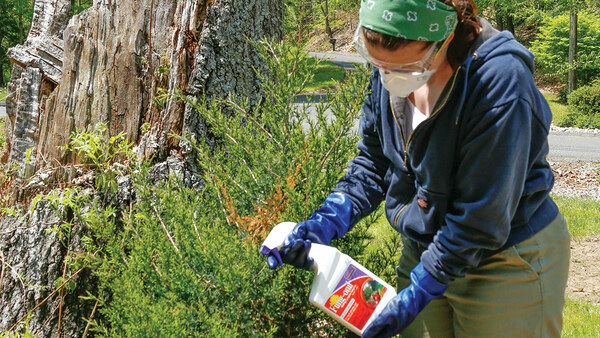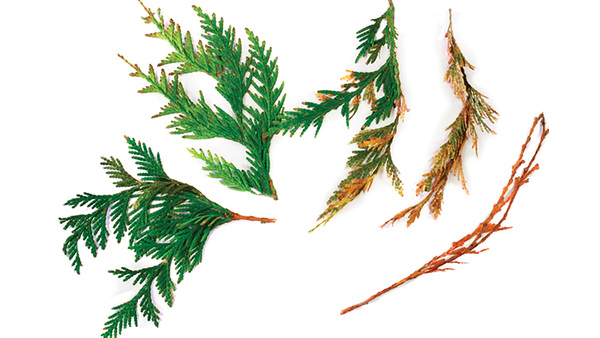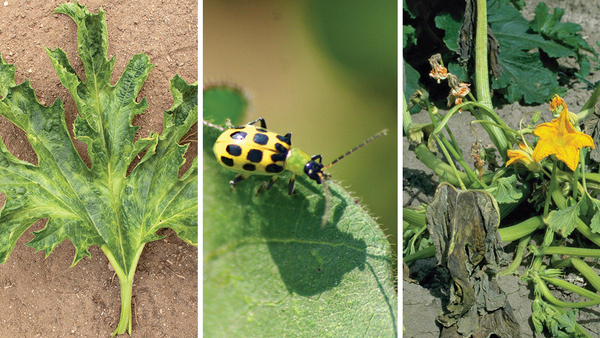
Gardeners are observant, and when a favorite plant is struggling, we tend to take notice. Knowing how to respond, however, is another matter entirely. Some folks head to the garden center looking for a cure-all, determined to spray first and ask questions later. But a gardener who invests just a little time to observe the signs and symptoms of a disease can often narrow down which pathogen is affecting the plant and then make an informed decision about what to do next.
When diagnosing plant problems, knowing the difference between a sign and a symptom is a good place to start. A symptom is a change in a plant’s growth or appearance that indicates a health problem, such as yellowing, wilting, dieback, or galls. You can’t base a diagnosis on symptoms alone, though, since several potential pests or pathogens may have caused the problem. For example, wilting leaves can be caused by a pathogen, but they can also be a symptom of drought stress, root rot, or an insect feeding on the plant’s stem. A sign is physical evidence of the damaging factor, such as mycelia (threads of fungus), spores, or pustules, and these are the clues that can help you to conclusively diagnose a problem.
The following descriptions of diseases that are likely to infect plants during the height of the growing season include their signs, symptoms, and some management strategies. Use them as a starting point, and then do some additional research if needed. You will soon know what is wrong with your plant, and what action to take.
Anthracnose
Look for irregular, spreading spots that follow leaf veins
Anthracnose can be caused by several fungi, including species in the genera Apiognomonia, Colletotrichum, and Discula. An infected plant typically has leaf spots or irregularly shaped lesions that continue into the main stem. There are anthracnose diseases of annuals, perennials, and woody broadleaf plants.

Symptoms and signs
Leaf spots expand and often spread down the midvein, into the petiole, and into the main stem of annuals and perennials, or into the branches of woody broadleaf hosts. The fungi that cause these diseases may be visible with the aid of a hand lens.
Life cycle
In woody plants, the fungi overwinter in infected twigs and buds, along with fallen leaf litter. In spring, the fungi produce spores that reach newly emerging leaves and shoots through rain splashes or wind. With annuals and perennials, spores are splashed up from last year’s leaf litter to infect new leaves and stems.
Cultural management
The best way to manage this disease on trees and shrubs is to use resistant varieties when available.
Resistant varieties
For an anthracnose-resistant dogwood, choose either ‘Appalachian Spring’ flowering dogwood (Cornus florida ‘Appalachian Spring’, Zones 5–9), Stellar Pink® dogwood (C. ‘Rutgan’, Zones 5–8), or Cornelian cherry (C. mas, Zones 4–8). Some resistance has been reported in London plane (Platanus × acerifolia, Zones 4–8) and hybrid sycamore cultivars such as ‘Bloodgood’, ‘Columbia’, and ‘Liberty’. For annuals and perennials, site plants to avoid sunscald, especially those varieties that have white variegated leaves or picotee, and avoid excess water and overhead irrigation.
Chemical management
For large trees, chemical management is not recommended. For smaller shrubs and perennials, growing the plants under the appropriate light conditions will reduce the need for fungicides. In years that are excessively wet, a rotation of Spectracide Immunox, Bonide’s Fung-onil Multi-purpose Fungicide, and/or Hi-Yield Captan 50W Fungicide is effective in protecting plants from infection during wet weather. Applications often need to begin at budbreak and to continue until the weather changes to hot and dry, or until the terminal buds on woody plants set.
Rust
Look for orange spores, pustules, or fruiting bodies
Rust fungi get their name from their conspicuous, abundant, orange-colored spores. These pathogens infect broadleaf and coniferous trees and shrubs, perennials, and annuals. Two of the most common rust genera that gardeners face are Puccinia and Gymnosporangium. Puccinia species cause rust on plants such as hollyhocks (Alcea spp. and cvs., Zones 3–9), snapdragons (Antirrhinum spp. and cvs., annual), reed grasses (Calamagrostis spp. and cvs., Zones 4–9), fountain grasses (Pennisetum spp. and cvs., Zone 6–11), goldenrods (Solidago spp. and cvs., Zones 3–9), bellflowers (Campanula spp. and cvs., Zones 3–9), heucheras (Heuchera spp. and cvs., Zones 3–8), sunflowers (Helianthus spp. and cvs., annual), and switchgrasses (Panicum spp. and cvs., Zones 5–9). To complete their life cycle, Gymnosporangium species must alternate between a coniferous primary host, usually a juniper (Juniperus spp. and cvs., Zones 2–10), and a secondary host in the rose family. They cause cedar-apple, cedar-quince, and cedar-hawthorn rust on fruiting trees such as crabapple (Malus spp. and cvs., Zones 3–9), flowering quince (Chaenomeles spp. and cvs., Zones 5–9), flowering pear (Pyrus spp. and cvs., Zones 4–9), and serviceberry (Amelanchier spp. and cvs., Zones 3–9). Cedar-quince rust (Gymnosporangium clavipes) is often the most damaging to landscape plants.


Symptoms and signs
For Puccinia pathogens, yellow spots on the upper leaf surface correspond to orange, powdery pustules on the underside of the same leaf. These spores transfer readily to hands when touched. With the juniper rusts, gelatinous orange fruiting bodies appear on the juniper host in early spring. With cedar-quince rust, the fruiting body may be inconspicuous and lie flat against the branch. Cedar-hawthorn rust creates a conspicuous, spore-producing “koosh ball” structure that may be mistaken for a bloom. On a rose-family host (e.g., apple, pear, flowering quince, or serviceberry), rust infection results in orange spots on upper leaf surfaces, green stems, and immature fruit.
Life cycle
To complete its life cycle, a rust fungus in the Puccinia genus may infect one or two hosts. The hollyhock rust completes its life cycle on hollyhock; the snapdragon rust completes its life cycle on snapdragon. Other Puccinia species, such as those that infect ornamental grasses, require two hosts: the grass host and either buckthorn (Rhamnus spp. and cvs., Zones 2–7) or barberry (Berberis spp. and cvs., Zones 4–8). Every Gymnosporangium rust requires two hosts: a rose-family host and a juniper-family host. Plants that are infected with these fungi cannot reinfect themselves. Spores from the juniper host are carried by wind and rain to the rose-family host, where they produce orange spots on upper leaf surfaces and fruit. Over time, these spots develop into tube-shaped structures on the undersides of the leaves or on the fruit. These structures release spores to reinfect the juniper host.
Cultural management
The best way to manage rust disease is to use resistant varieties when they are available. Varieties that are more resistant to hollyhock rust include figleaf hollyhock (Alcea ficifolia, Zones 3–9), ‘Happy Lights’ hollyhock (A. ficifolia ‘Happy Lights’, Zones 3–9), Russian hollyhock (A. rugosa, Zones 4–8), mallow (Malva alcea and cvs., Zones 4–7), and checkerbloom (Sidalcea malviflora and cvs., Zones 5–9), all of which are less susceptible than cottage hollyhock (A. rosea, Zones 2–10). For rust-resistant snapdragons, try seeking out ‘Wisley Golden Fleece’, ‘White Monarch’, and ‘Orange Glow’, but be aware that obtaining these older varieties is often challenging. I simply plant hollyhocks and tall snapdragons in the back of the garden and celebrate the rusty orange biodiversity!
Fortunately, most crabapples are selected to be rust resistant, but avoid susceptible heirloom varieties such as ‘Bechtel’s Select’ or ‘Prairie Rose’ (Malus ioensis ‘Prairie Rose’, Zones 4–7). For hawthorn (Crataegus spp. and cvs., Zones 3–8) and serviceberry, the cedar-quince rust fungus attacks fruit and new succulent stem tissue, severely disfiguring plants. There are no validated reports of commercially available serviceberry or hawthorn species or cultivars with resistance to cedar-quince rust. However, there are junipers that have been reported to be more rust resistant, and using them instead of their susceptible counterparts is one way to flatten the juniper rust curve. As rust spores can travel miles, removing the susceptible juniper or rose-family host might reduce infections but will not eliminate them.
Chemical management
Rotating the application of Spectracide Immunox with Bonide’s Fung-onil Multi-purpose Fungicide will protect against many common landscape rusts. It is important to learn the life cycle of rust fungi. For self-infecting rusts, such as hollyhock or rose, protection may need to be applied every 7 to 14 days when conditions are conducive for disease. For control of the juniper rusts, protecting plants in early spring just before flowering with an application of Immunox followed by an application of Fung-onil Multi-purpose Fungicide after petal fall, followed by a second application of Immunox, should significantly reduce the infection on landscape shrubs. For organic growers, well-timed applications of sulfur can suppress infection, but be careful during hot weather, when sulfur can drive mite flare-ups.
Botrytis blight
Look for leaf spot, blight, and fuzzy gray mold
Also called gray mold, botrytis blight is a common disease of annuals, perennials, and some woody plants. Dozens of species of Botrytis fungi can infect garden plants, including but not limited to Botrytis cinerea, which has many hosts, and Botrytis elliptica, which infects gladiolus (Gladiolus spp. and cvs., Zones 7–10) and lilies (Lilium spp. and cvs., Zones 3–9). Botrytis paeoniae infects peonies (Paeonia spp. and cvs., Zones 3–8), and Botrytis tulipae infects tulips (Tulipa spp. and cvs., Zones 3–9).

Symptoms and signs
A plant infected with botrytis may exhibit leaf spot spreading into blight, shoot blight, crown rot, or damping off. Signs of botrytis include fuzzy gray mold growing on the surface of the infected tissue, commonly appearing on the flowers and buds of infected plants. Occasionally, black flakes or even balls of fungus called sclerotia may appear in infected material.
Life cycle
Overwintering sclerotia in a garden produce spores in spring during cool, wet conditions. Within days of infection, the fungus begins to produce spores to continue the spread of this disease. Hundreds of thousands of spores can be produced from a single lesion. Buds, flowers, new shoots, leaves, and injured plant parts are all highly susceptible to infection. Leaf wetness is necessary for spores to germinate and infect plants.
Cultural management
Cultural management of botrytis includes incorporating disease-resistant plants when available, reducing leaf wetness by adequately spacing plants and avoiding overhead irrigation, removing decayed or damaged flowers and leaves, and removing spent plant material at the end of the growing season. Avoid overfertilizing, as too much nitrogen can cause excessive, succulent growth that is highly susceptible to botrytis infection.
Resistant varieties
Botrytis-resistant peony cultivars include ‘America’, ‘Buckeye Belle’, ‘Krinkled White’, ‘Old Faithful’, ‘Pink Hawaiian Coral’, ‘Roselette’, ‘Scarlet O’Hara’, and ‘White Cap’. In general, single-flowered peonies are more resistant to botrytis than “bomb” types. Resistant bedding plants include ‘Fantasy Blue’ petunia and Tidal Wave® Hot Pink petunia (Petunia cvs., annual). Cora® series vincas (Catharanthus roseus cvs., annual) had very good resistance to botrytis infection in at least one fungicide trial.
Chemical management
You can use Bonide’s Fung-onil Multi-purpose Fungicide or Hi-Yield Captan 50W. If you are looking for an organic option, Bonide’s Revitalize Biofungicide may reduce disease spread, but it has not performed as well as Fung-onil or Captan in trials. All fungicides perform best when applied before symptoms appear (e.g., as flower buds develop). To effectively protect tissue, they will need to be reapplied every 7 to 10 days when conditions are favorable for disease.
Downy mildew
Look for angular leaf spots and mildew on the bottom of leaves
Downy mildew is a complex of common diseases of annuals, perennials, and some woody plants. Different species in the genus Peronospora infect bee balms (Monarda spp. and cvs., Zones 4–9), butterfly bushes (Buddleia spp. and cvs., Zones 5–9), coleus (Coleus cvs., Zone 11), roses (Rosa spp. and cvs., Zones 2–11), and salvias (Salvia spp. and cvs., Zones 5–11). Species in the genus Plasmopara infect impatiens (Impatiens cvs., Zones 9–11), sunflowers, black-eyed Susans (Rudbeckia spp. and cvs., Zones 3–9), and viburnums (Viburnum spp. and cvs., Zones 2–9), including highbush cranberry (V. opulus var. americanum, Zones 2–7). Most downy mildews have a very narrow host range and only infect members of a single plant-host genus, or even just a single species.


Symptoms and signs
Signs of downy mildew include white to gray or even black fine mildewing growth often on the underside of leaves. Angular leaf spots may result in leaf drop or blight. Sporulation often becomes visible under wet and highly humid conditions.
Life cycle
Oospores (thick-walled structures that form the resting stage of the pathogen) overwinter in leaf litter, then germinate in spring. The pathogen may then directly infect roots or produce spores that swim across wet leaves and soil to infect nearby plants. Plants can quickly succumb to infection under cool, wet conditions, or they may persist through hot, dry weather only to succumb when the weather becomes cool and wet.
Cultural management
Water management is an essential component of downy mildew management. Manage leaf wetness by adequately spacing plants and avoiding overhead irrigation. Remove decaying or damaged flowers and leaves during the growing season, and remove all spent plant material at the end of the growing season. Do not overfertilize plants with nitrogen. Excessive, succulent growth is highly susceptible to botrytis infection.
Resistant varieties
For impatiens that are more resistant to downy mildew, choose ‘Beacon’ or ‘Imara’. If you are looking for a resistant black-eyed Susan, avoid ‘Goldsturm’; 12 other species of Rudbeckia were found to be less susceptible to downy mildew than ‘Goldsturm’, including annual cultivars and ‘Viette’s Little Suzy’.
Chemical management
Monterey AgriFos, rotated with either Hi-Yield Captan 50W or Bonide’s Fung-onil Multi-purpose Fungicide, is effective in protecting plants from infection. No fungicide will cure infected plants. All fungicides perform best when applied before symptoms appear, and their use needs to be continued on a 7- to 14-day schedule when conditions are favorable for disease.
Janna Beckerman is a professor and extension plant pathologist in Purdue University’s Department of Botany and Plant Pathology in West Lafayette, Indiana.
Photos: courtesy of Janna Beckerman





















Comments
Log in or create an account to post a comment.
Sign up Log in